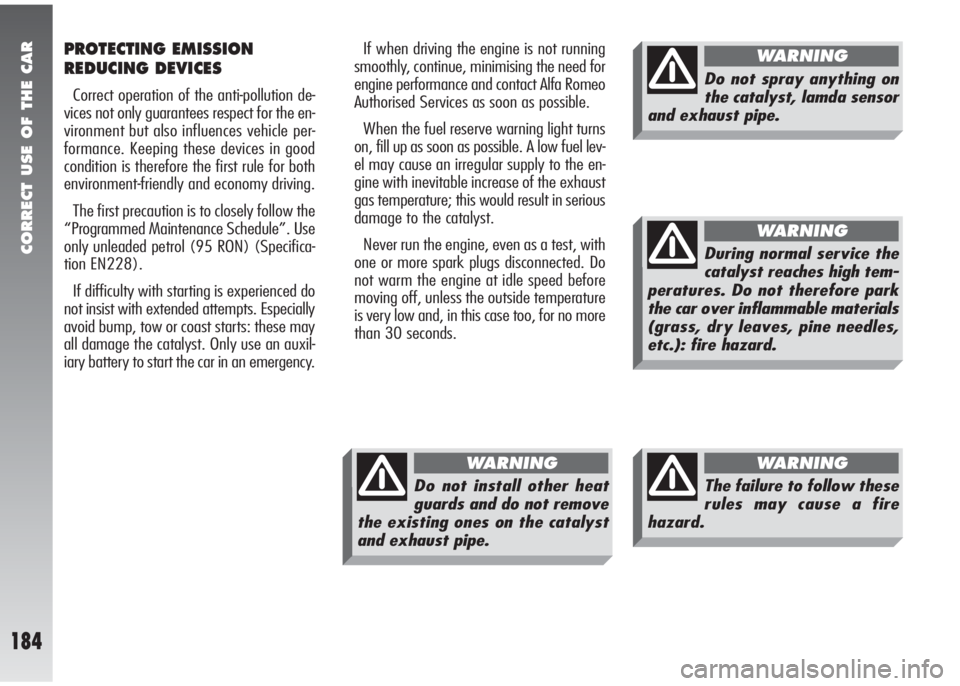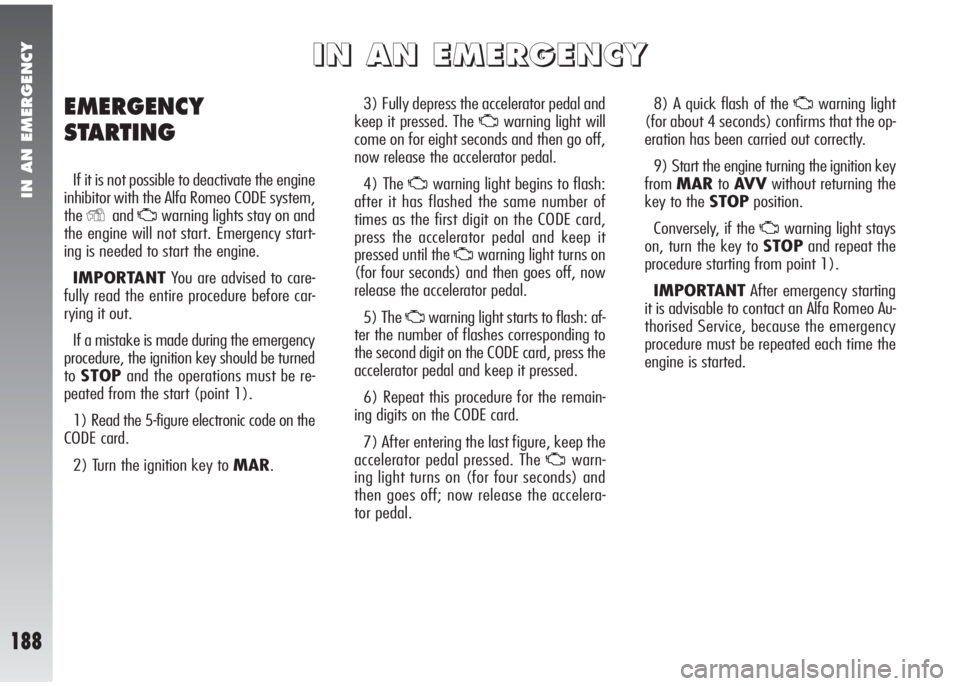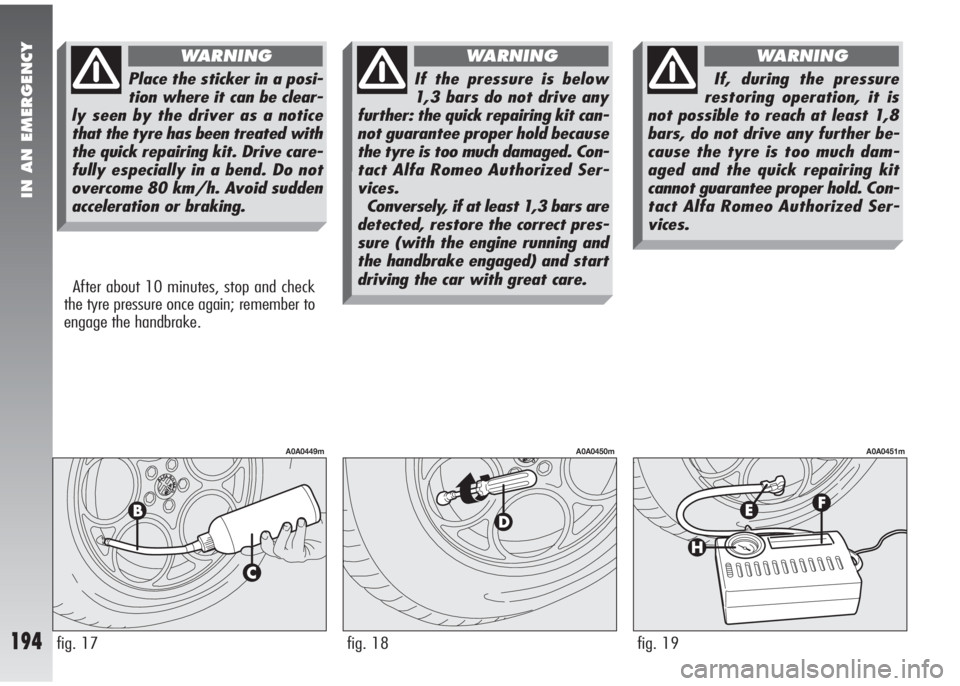ESP Alfa Romeo 147 2005 Owner handbook (in English)
[x] Cancel search | Manufacturer: ALFA ROMEO, Model Year: 2005, Model line: 147, Model: Alfa Romeo 147 2005Pages: 291, PDF Size: 5.52 MB
Page 186 of 291

CORRECT USE OF THE CAR
184
PROTECTING EMISSION
REDUCING DEVICES
Correct operation of the anti-pollution de-
vices not only guarantees respect for the en-
vironment but also influences vehicle per-
formance. Keeping these devices in good
condition is therefore the first rule for both
environment-friendly and economy driving.
The first precaution is to closely follow the
“Programmed Maintenance Schedule”. Use
only unleaded petrol (95 RON) (Specifica-
tion EN228).
If difficulty with starting is experienced do
not insist with extended attempts. Especially
avoid bump, tow or coast starts: these may
all damage the catalyst. Only use an auxil-
iary battery to start the car in an emergency.If when driving the engine is not running
smoothly, continue, minimising the need for
engine performance and contact Alfa Romeo
Authorised Services as soon as possible.
When the fuel reserve warning light turns
on, fill up as soon as possible. A low fuel lev-
el may cause an irregular supply to the en-
gine with inevitable increase of the exhaust
gas temperature; this would result in serious
damage to the catalyst.
Never run the engine, even as a test, with
one or more spark plugs disconnected. Do
not warm the engine at idle speed before
moving off, unless the outside temperature
is very low and, in this case too, for no more
than 30 seconds.
Do not spray anything on
the catalyst, lamda sensor
and exhaust pipe.
WARNING
The failure to follow these
rules may cause a fire
hazard.
WARNING
Do not install other heat
guards and do not remove
the existing ones on the catalyst
and exhaust pipe.
WARNING
During normal service the
catalyst reaches high tem-
peratures. Do not therefore park
the car over inflammable materials
(grass, dry leaves, pine needles,
etc.): fire hazard.
WARNING
Page 190 of 291

IN AN EMERGENCY
188
3) Fully depress the accelerator pedal and
keep it pressed. The
Uwarning light will
come on for eight seconds and then go off,
now release the accelerator pedal.
4) The
Uwarning light begins to flash:
after it has flashed the same number of
times as the first digit on the CODE card,
press the accelerator pedal and keep it
pressed until the
Uwarning light turns on
(for four seconds) and then goes off, now
release the accelerator pedal.
5) The
Uwarning light starts to flash: af-
ter the number of flashes corresponding to
the second digit on the CODE card, press the
accelerator pedal and keep it pressed.
6) Repeat this procedure for the remain-
ing digits on the CODE card.
7) After entering the last figure, keep the
accelerator pedal pressed. The
Uwarn-
ing light turns on (for four seconds) and
then goes off; now release the accelera-
tor pedal.8) A quick flash of the
Uwarning light
(for about 4 seconds) confirms that the op-
eration has been carried out correctly.
9) Start the engine turning the ignition key
fromMARtoAV Vwithout returning the
key to the STOPposition.
Conversely, if the
Uwarning light stays
on, turn the key to STOPand repeat the
procedure starting from point 1).
IMPORTANTAfter emergency starting
it is advisable to contact an Alfa Romeo Au-
thorised Service, because the emergency
procedure must be repeated each time the
engine is started.
EMERGENCY
STARTING
If it is not possible to deactivate the engine
inhibitor with the Alfa Romeo CODE system,
the
YandUwarning lights stay on and
the engine will not start. Emergency start-
ing is needed to start the engine.
IMPORTANTYou are advised to care-
fully read the entire procedure before car-
rying it out.
If a mistake is made during the emergency
procedure, the ignition key should be turned
toSTOPand the operations must be re-
peated from the start (point 1).
1) Read the 5-figure electronic code on the
CODE card.
2) Turn the ignition key to MAR.
I I
N N
A A
N N
E E
M M
E E
R R
G G
E E
N N
C C
Y Y
Page 196 of 291

IN AN EMERGENCY
194fig. 17
A0A0449m
fig. 18
A0A0450m
fig. 19
A0A0451m
After about 10 minutes, stop and check
the tyre pressure once again; remember to
engage the handbrake.
Place the sticker in a posi-
tion where it can be clear-
ly seen by the driver as a notice
that the tyre has been treated with
the quick repairing kit. Drive care-
fully especially in a bend. Do not
overcome 80 km/h. Avoid sudden
acceleration or braking.
WARNING
If the pressure is below
1,3 bars do not drive any
further: the quick repairing kit can-
not guarantee proper hold because
the tyre is too much damaged. Con-
tact Alfa Romeo Authorized Ser-
vices.
Conversely, if at least 1,3 bars are
detected, restore the correct pres-
sure (with the engine running and
the handbrake engaged) and start
driving the car with great care.
WARNING
If, during the pressure
restoring operation, it is
not possible to reach at least 1,8
bars, do not drive any further be-
cause the tyre is too much dam-
aged and the quick repairing kit
cannot guarantee proper hold. Con-
tact Alfa Romeo Authorized Ser-
vices.
WARNING
Page 198 of 291

IN AN EMERGENCY
196
D.-E. Halogen bulbs
To remove, free it from the clip on
its housing.GENERAL INSTRUCTIONS
– When a light is not working, check that
the corresponding fuse is intact before
changing a bulb.
– For the location of fuses, refer to the
paragraph “In the event of a burnt fuse”
in this chapter.
– Before changing a bulb check the con-
tacts for oxidation.
– Burnt bulbs must be replaced by oth-
ers of the same type and power.
– Always check headlight aiming after
changing a bulb to ensure they are safe.
TYPES OF BULBS (fig. 21)
Various types of bulbs are fitted to your ve-
hicle:
A. All glass bulbs
These are pressed on. Pull to remove.
B. Bayonet type bulbs
Press the bulb, turn counter-clockwise
to remove this type of bulb from its
holder.
C. Tubular bulbs
Free them from their contacts to re-
move.
fig. 21
A0A0453m
Page 205 of 291

IN AN EMERGENCY
203
– Remove the bulb pushing it gently and
turning it counter-clockwise.
– Replace the bulb.
– Refit the bulb holder turning clockwise
and checking that it is secured correctly.SIDE DIRECTION INDICATORS
(fig. 30)
– Push the transparent cover towards the
rear of the car to compress the catch (A).
Release the front part and remove this unit.
– Turn the bulb holder counter-clockwise
(B) and remove it from the cover.
– Remove the snap-fitted bulb and replace
it.
– Insert the bulb holder (B) in the trans-
parent cover, then position the unit mak-
ing sure the catch clicks into place (A).
REVERSING LIGHTS
AND REAR FOG GUARDS
(fig. 31-32)
The reversing light and rear fog guard are
in the tail light unit fastened to the tailgate;
they are to be found respectively one on the
right and the other on the left of the vehicle
facing forwards.
To change the bulb, proceed as follows:
– Open the tailgate.
– Remove the cap (A) then, using the ex-
tension with the screwdriver provided (work-
ing as illustrated), loosen the fastening nuts
(B) of the light unit concerned.
fig. 31
A0A0167m
fig. 29
A0A0455m
fig. 30
A0A0166m
Page 208 of 291

IN AN EMERGENCY
206
PUDDLE LIGHT (fig. 38)
(for versions/markets
where applicable)
To change the bulb proceed as follows:
– Open the door and slacken the screw
(A) fastening the transparent covers.
– Remove the unit composed of the two
transparent covers then change the bulb, re-
leasing it from the side contacts making sure
that the new bulb is correctly clamped be-
tween the contacts.
– Realign the two transparent covers and
tighten the fastening screw (A).IF AN INTERIOR
LIGHT GOES OUT
FRONT ROOF LIGHT
(fig. 39-40)
To change the bulbs proceed as follows:
– Remove the light unit (A) levering in
the points shown by the arrow (in corre-
spondence with the retainer catches).
– Open the protective cover (B).
– Replace the bulb concerned releasing it
from the side contacts making sure that the
new bulb is correctly clamped between the
contacts.– Close the protective cover (B).
– Refit the light unit pressing gently in cor-
respondence with the retainer catches, un-
til hearing the click.
fig. 40
A0A0176m
fig. 39
A0A0175m
fig. 38
A0A0174m
Page 212 of 291

IN AN EMERGENCY
210
The fuses of the Alfa 147 GTAare
grouped in three control boxes, to be found
respectively on the dashboard, on the battery
positive pole and next to the actual battery.
Access is gained to the control box on the
dashboard by slackening the two retainers
(A-fig. 50) and removing the protective
trim (B).
To access the fuses in the control unit on
the battery pole, it is necessary operate in
the direction shown by the arrows on the
blocking devices (A-fig. 51) and then
open the 2 covers (B).
To access the fuses of the control unit lo-
cated near the battery, it is necessary to op-
erate in the opposite way on the retaining
devices (C), and then remove cover (D).
To locate the protection fuses, consulting
the summary table on the following pages,
refer to the following illustrations fig. 52,
fig. 53and54.
fig. 50
A0A0186m
fig. 52 - Control box on dashboard
A0A0134mfig. 51
A0A0493m
Page 214 of 291

IN AN EMERGENCY
212
Hazard warning light
Right dipped-beam headlight
Left dipped-beam headlight
Main-beam headlight
Foglight
Braking light
Reversing light
+30 direction indicators10
10
10
15
15
10
7.5
10 F53
F12
F13
F2
F30
F37
F35
F53 52
52
52
53
53
52
52
52
LIGHTS FIGURE FUSE AMPERES
FUSE SUMMARY TABLE
30
30
10
7.5
15
7.5
7.5 IGN (MAXI-FUSE)
F13
F31
F39
F1
F31 54
54
52
52
52
53
52
SERVICES FIGURE FUSE AMPERES
Selespeed transmission pump
Ignition switch
Headlight aiming device
Climate control system
Climate control system
Climate control compressor
Heater unit relay coils
Page 215 of 291

IN AN EMERGENCY
213
15
7.5
7.5
15
15
15
20
20
30
30
20
15
7.5
7.5
20
20
15
7.5
15
7.5 F32
F11
F51
F39
F39
F52
F33
F34
F40
F43
F44
F45
F41
F35
F38
F5
F39
F8
F9
F49 52
53
52
52
52
52
52
52
52
52
52
52
52
52
52
53
52
53
53
52
SERVICES FIGURE FUSE AMPERES
Key-operated +30
Selespeed transmission
Selespeed transmission
Radio
Navigator
Rearscreen wiper
Left rear power window
Right rear power window
Rearscreen heating
Windscreen - rearscreen washer (two-way pump)
Cigar lighter
Seats with electric heating
Heated wing mirrors - heated nozzles
Cruise control
Central door locking
Headlight washer
Services + 30
Primary services (electronic injection)
Secondary services (electronic injection)
Secondary services
Page 221 of 291

IN AN EMERGENCY
219
IN THE EVENT
OF AN ACCIDENT
– It is important to keep calm.
– If you are not directly involved, stop at
least a few dozen metres away from the ac-
cident.
– On motorways, stop without blocking
the emergency lane.
– Turn the engine off and the hazard warn-
ing lights on.
– At night, illuminate the place of the ac-
cident with the headlights.
– Take care, do not risk being run over.– Signal the accident placing the triangle
at regulation distance in a clearly visible
place.
– Call the emergency organisation, giving
the most accurate information possible. On
motorways use the special phones provid-
ed.
– In motorway pileups, especially with
poor visibility, the risk of being involved in
other crashes is high. Leave the car imme-
diately and go beyond the guard-rail.
– If the doors are blocked, do not try to
get out of the car breaking the windscreen
which is stratified. The windows and rear
screen are easier to break.
– Remove the ignition key of the vehi-
cles involved.– If you note a smell of fuel or other chem-
ical products, do not smoke and have ciga-
rettes stubbed out.
– To put out fires, even small ones, use
the extinguisher, blankets, sand, or earth.
Never use water.
– If use of the lighting system is not nec-
essary, disconnect the battery negative ter-
minal (–).